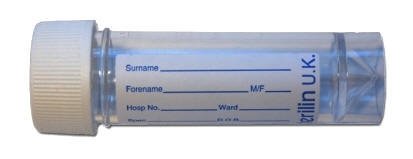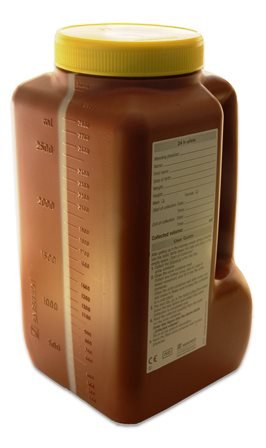Cystine (Urine)
Chemical Pathology
Notes
- Cystinuria is caused by a defect in cystine transport in the kidney. Cystine accumulates in the urine, which can lead to crystals and ultimately renal stone formation.
- Around 1 in 2000 people in the UK are affected by cystinuria. It is an inherited condition. Most individuals will present with cystinuria when they are between 20 – 40 years old, although it can present at any age.
- Urine cystine measurement should be requested in patients with suspected cystinuria (for example if there is a family history of the disease) or where there are unexplained episodes of renal stone formation.
- Measurement is also indicated for monitoring of known cystinuria patients.
Sample requirements
1. Screening for cystinuria
A random urine sample collected into a 30mL Universal

2. Monitoring known cystinuria
- Monitoring of cystinuria requires knowledge of peak urine cystine concentrations occurring and this is best achieved by measuring urine cystine concentration.
- A 24h urine collection can be measured but peak nighttime concentrations may be hidden by the lower daytime levels when there is greater fluid intake.
- For this reason a better assessment is two separate but consecutive 12 hour collections for daytime and nighttime (e.g. 9am to 9pm and then 9pm to 9am).
- Alternatively an early morning urine may provide an index of urine cystine levels overnight. The best approach will be patient dependent and requests should be discussed with the duty biochemist to allow appropriate sample collection and handling in the laboratory.
For timed (12 hour or 24 hour) urine collections the brown urine bottle shown below and available via the GP surgery or from Pathology reception should be used.

Storage/transport
Random urine sample should be sent promptly to the laboratory at ambient temperature.
Timed urine collections should be transported to the laboratory as soon after the urine collection is completed and preferably within 24 hours of completion.
Required information
Relevant clinical details, including details of clinical presentation.
Turnaround times
Samples are sent to an external location for analysis with a result expected back within 3 weeks.
Reference ranges
Random urine cystine
- Results for screening are reported with age related ranges and interpretive comments.
Known cystinuria
- Urine cystine concentrations are generally best kept at less than 1000 µmol/L but this will depend on urine pH and current treatment. Individual patient results should therefore be assessed by the specialist responsible for the patient's care.
24 hour urine collections
- Females: urine cystine 15 – 55 µmol/24 hrs
- Males: urine cystine 15 – 140 µmol/24 hrs.
Further information
For more information see CystinuriaUK
Page last updated 29/04/2024